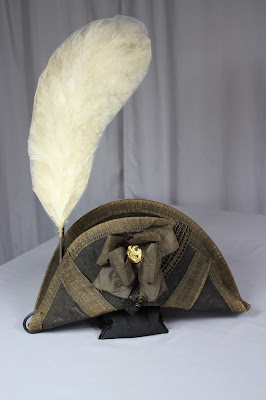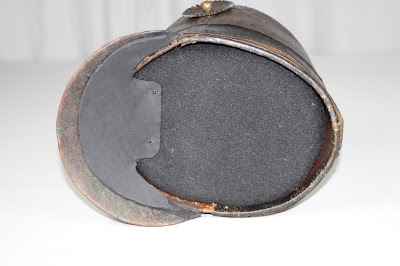Hats and head coverings are a broad category. They can be large like a chapeau, tall like a shako, tight like a fez, slouch like a beret, have a brim like a kepi, be rigid like a helmet, have a display of feathers like a headdress, and have all sorts of composite accessories, like metal buttons, leather straps, plumes, silk lining, wool tassels, or grosgrain ribbons, to name a few. The conservation of a hat is a complex task; hats can be composed of many materials, and have very different purposes or uses.
This blog entry will focus on a few military style hats, which Spicer Art Conservation recently conserved and mounted at for storage or for display in an upcoming exhibit. Each hat required a problem-solving approach to address various concerns, including:
- Recreating a 3-dimensional hat from a flattened hat
- The sometimes excessive and "mixed media" decoration on hats
- Weak and vulnerable areas of hats, many naturally occurring along folds or creases
- Accessory pieces, like plumes (which are a separate artifact), but are displayed together
- Creating exhibit mounts and storage mounts to fit the needs of the individual artifact
Decorative elements:
Hats, particularly those worn by military officers, feature decorative elements such as metal pins, insignia, or embroidery. Some hat decoration is intended to represent the wearer's military branch, company or unit. These decorative elements can be considered mixed-media, composed of various types of fabric materials, metals, or metallic thread.
 |
| A detail image of an Officer's Chapeau, c 1810, shows the various materials involved in its construction; silk ribbon, wool, braided elements, ribbon with metallic thread, metal eagle. |
The hat below (an officer's chapeau circa 1832) composed mainly of beaver pelt is complex and highly decorative. The front, or cock, of the hat features taffeta ribbon, grosgrain ribbon ruffle, thickly embroidered knotted braiding and embellished pieces (including unique horse shoe shapes), metal button, and gold-toned metal eagle with a banner pin above, which reads: "E Pluribus Unum". At each of the cocked ends (not visible in photo) are thick tassels of metallic thread.
 |
| A detail image of the complex decoration. During cleaning of the metal elements, the other fabric decorative pieces must be protected with a barrier material. |
Each hat that is conserved at SAC is custom fitted with an internal support created from carved ethafoam and covered with pre-washed 100% cotton stockinette. The hat with its internal support are placed on a handling tray. It is the tray that moves in and out of the storage box, therefore reducing or eliminating the handling of the hat itself (see photo below).
Plumes:
Plumes are a hat accessory that often accompany shako or chapeau style hats. The plumes are created from feathers, but can also be more of a long flowing item, created from horse hair. When these plumes were originally part of the hat, they were originally fastened to the hat by being slid into an applied sleeve located at the brim, hat band area, inside the crown, or sometimes tucked behind the decorative elements at the front of the hat. Artifact hats, especially those that are quite fragile, are no longer able to support the plume as they once did. Plumes that are original to the hat, like the one featured in the image below, can be quite rare. These fragile items require their own treatment and stabilization (see image below).
(LEFT) This feathered plume from an officer's chapeau, circa 1810, was quite fragile. The plume requires its own stabilization and encapsulated in a fine net to secure the small brittle ends of the feathers that were prone to breaking off. It will also be supported with a custom made Vivak mount to hold it in the proper position and angle (RIGHT). The accompanying hat (see below) was no longer able to support the plume as it had originally been inserted into a fabric sleeve on the reverse of the hat's front.
Display mounts to provide optimal support and incorporate accessories:
As mentioned in the above section about plumes, accessories which were original to the hat, may not be able to be incorporated as they originally were intended. The plume discussed above had been held onto the hat with a fabric sleeve (see photo below).
The sleeve had been sewn to the hat with threads that were now loose and quite fragile. Placing the plume back into this sleeve would weaken the sleeve and place the the hat at risk for tearing, and the plume at risk for falling, therefore causing potential damage to both artifacts. (Additionally, the plume could no longer be displayed with such minimal support to its base).
The solution was in the mount. The creative mount for the plume to be seamlessly displayed with the chapeau was fabricated by BRIGID MOUNTMAKING. The unique, custom mount would address the display of the two artifacts together, the full support of the hat (both inside the crown and the weak pointed ends), and the delicate plume, which required encapsulation in a fine net to minimize the loss of the breaking barbs of each feather, but also required a custom made Vivak cradle to hold and support it in the proper, supportive, position. Vivak is a polyethylene terephthalate glycol (PETG). It is clear and is easily bendable with low heat, perfect for subtle shaping needed for such purposes as this.
 |
| The two display mount pieces: the hat mount (before the hat has been placed on it) and the plume mount, as they fit together. Now, the two-piece mount is ready for the Chapeau and ready for exhibit! |
The two-pieces of the display mount work in synchronicity. The internal body of the hat is supported by the cotton stockinette covered portion, which fits directly inside of the chapeau. The black display fabric covered base will provide the support to the fragile pointed ends of the hat.
Once the hat has been placed on its display support, the plume mount is slid into its receiving end and secured. The plume mount, while placed close to the hat, does not rub or rest on the hat in any way, and is not distracting to the viewer. The hat is now ready for exhibit.
 |
| After treatment photograph of the exhibit ready mounted hat and plume. |
Material composition:
We have conserved hundreds of hats at SAC. The hats have been made from leather, wool, cotton, silk, beaver pelt, molded plastic, synthetic textiles, and every combination of fabrics. Each fabric behaves differently based on its age, its past use, the way it has been displayed or stored, and how much light it has been exposed to over time.
The hat below is an officer's foraging cap from the American Civil War, featuring a quatrefoil design applied with soutache braiding. The hat features a variety of materials including, leather, wool, silk, brass, metallic thread, and velvet pile fabric.
When a hat is composed of many different fabrics and materials, each piece must be considered individually when approaching the overall treatment of the hat and its needs for stabilization. For example, the close-up of the foraging cap (see below) shows where the crown, composed of wool, meets a decorative hat band of velvet, which is further embellished with a leather hat band with brass buttons. On the inside, it is stitched to a sweatband made of tanned leather.
A hat like this with its various parts must be mounted to support all of the pieces of the crown, but the mount must support the heavy but fragile brim. Below, the underside of the supported hat can be seen. Here the brim support, was mad using Vivak and then covered in black cotton fabric, is attached to the base of the mount. It is positioned just under the brim of the hat to provide stability and support (while always using only archival materials).
Hat brims, whether they are just at the front of the hat (like a baseball style hat), or if they extend outward around the entire circumference of the hat (like a cowboy hat, or a sombrero) must have stability provided to this overhanging area. Without stability, the area of attachment of the brim to the hat grows weaker or in some cases separates from the hat entirely, such was the case with the leather shako hat below (see image below).
 |
| The shako and its brim; here in two pieces that needed reattachment and increased stability. There are times when treatment alone is not sufficient. |
The 200+ year old leather shako and its leather brim required a reunion. But how to keep them together in a more supportive way? The shako had been mended before, but the weight of hat and brim and their precarious intersection were factors that would lead ultimately to a possible failure in the repair, especially if the hat was improperly supported during handling. The answer once again, was in creating custom formed full brim support of Vivak covered with black cotton fabric, and placing it under the brim, directly attached to the internal support materials (see photo below):
THINK HOLISTICALLY:
Remember that hats are 3-dimensional, and keep in mind that they can only achieve 3-dimensionality with support and must be properly mounted to maintain their shape. At Spicer Art Conservation we constantly strive to provide the best conservation of an artifact, which includes the repair or stabilization of the item, the best way to allow the item to be fully understood, studied or displayed, while keeping handling to a minimum. Our mounting methods, whether for storage or for display are holistically considered to provide full support of the artifact, enable minimal handling, and when possible enable seamless transition from storage to exhibit.
Read more about choosing the right filling materials for your hat in our former blog post "Supporting textile artifacts without tissue paper - save a tree!", where we discuss the downfalls of stuffing hats (and other 3-D artifacts) with tissue paper.
Make sure you visit Brigid Mountmaking's website to see the amazing work that they do.
Are there hats in your collection that need care? Contact us by phone or email, we are happy to help.
Gwen Spicer is a conservator in private practice who is a recognized expert in the care of textiles, object, paper and upholstered artifacts.













No comments:
Post a Comment